Most of us have an opinion about Robert Blake’s culpability in his ex-wife’s death, but trial prosecutors “couldn’t put the gun in his hand” (in the words of a Blake trial juror) and that’s the name of that tune. For a reason that had nothing to do with the case, a part of me that felt glad when I read of his acquittal yesterday. I used to tool around on a scooter when I first came to L.A. in ’83, and one day it was stolen. I reported the loss to the cops right away, and a few hours later an officer called to say it had been found in Studio City. I was told where to go to pick it up (i.e., a location on the concrete L.A. river bed near Magnolia), and when I got there I saw two uniformed cops approaching from a couple hundreds yards away with a much shorter civilian walking between them. The civilian was Blake — he was the one who had spotted the abandoned scooter and made the call.
Seven and a half years…whoa…after the opening of Titanic in late ’97, writer-director James Cameron has finally gotten down to assembling material for a special-edition DVD. Actually, two Titanic packages will hit the market next October — a two-disc special edition and a four-disc collector√¢‚Ǩ‚Ñ¢√É‚Äû√ɬ¥s edition. Among the bonuses with be all those deleted scenes fans have been talking about for years. (Roughly an hour’s worth, including the longer build-up to Kate Winslet’s attempted suicide and the Leo “payback” scene when he wallops David Warner.) The “arduous” process of making Titanic was so hard on Cameron’s psyche, he says in the press release, that “until recently, I wasn√¢‚Ǩ‚Ñ¢√É‚Äû√ɬ¥t really ready to dive back into it all.” In fact, Cameron hasn’t been ready to dive into directing a movie since. He’s supposed to be working on a 3D adaptation of a Japanese graphic novel called “Battle Angel”…but he’s been so slow or reluctant to pull the trigger on various other “maybe” projects, I’ll believe the “Battle Angel” stories when I hear the film has begun principal photography.
This is going to sound odd, but Universal Pictures and Double Feature partners Michael Shamberg and Stacy Sher are planning on dramatizing the wrong 9/11 story.

I don’t mean it that way, exactly. How could “wrong” apply to a true-life story about surviving the World Trade Center disaster? But Shamberg and Sher are focusing on a generic rescue saga instead of (and this only a portion of it) a mind-bending divine intervention story that happened only a few dozen yards away from the subjects of their movie, and at precisely the same time.
The Shamberg-Sher story is about a couple of Port Authority police officers named Will Jimeno and John McLoughlin, who found themselves buried inside a small pit under 20 feet of rubble after the collapse of the North Tower, and were eventually found and dug out. They were the last two victims to be pulled alive from the rubble.
But as Jimeno and McLoughlin struggled to be heard and rescued, there was another Port Authority employee named Pasquale Buzzelli who was lying unconscious on a large piece of concrete 30 or 40 feet above them. And his story — what he was doing before the collapse of the North Tower, how he happened to survive it despite being on or near the 22nd floor, how he dealt with the aftermath — has all kinds of haunts and echoes.
< ?php include ('/home/hollyw9/public_html/wired'); ?>
Thank fortune Jimeno and McLoughlin survived, but dramatically speaking (and I realize that it sounds heartless to discuss a 9/11 story in terms of its audience- grabbing potential) theirs is a fairly standard scenario. I’m not trying to minimize or in any way dismiss the horror of what it was, but in movie terms it’s familiar.
Does anyone remember Dorothy Malone’s character being pinned under collapsed metal beams in 1960’s The Last Voyage, and finally getting carried out by husband Robert Stack and ship worker Woody Strode? Or the mineworker pinned under beams (and exploited by reporter Kirk Douglas) in 1951’s Ace in the Hole?
And how many times have we seen televised rescue dramas on local news shows about a kid who’s fallen into a well or sinkhole, etc.?
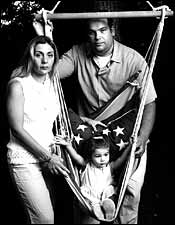
Louise and Pasquale Buzzelli, with their daughter Hope, in a photo that ran in New York magazine about 18 months ago.
Of course, the backdrop and circumstance of Jimeno and McLoughlin’s rescue will pack a wallop. But once you get past the 9/11 nightmare vibe (i.e., if you can step back and look at the story dispassionately), the story has a rote feeling.
Presumably Shamberg-Sher pounced on this because Jimeno and McLoughlin were the last people to be rescued from Ground Zero. Maybe someone can tell me what’s interesting about being the last. I mean, as opposed to being the first or the second-to-last or one of the guys in the middle group. Maybe it’s me.
The Shamberg-Sher project has no start date, but it has a completed script by Andrea Berloff. The project was brought to Shamberg-Sher by producer Debra Hill, who died from cancer less than two weeks ago.
Shamberg or Sher didn’t pick up, but according to critic and film historian Stephen Farber, who referred to this Universal-based project in a New York Times story that ran last Sunday (on 3.13), Universal is “happy” with the script. Farber passed along a sourced expectation that shooting will “hopefully start in the fall.”
There’s also a Columbia 9/11 project in the works, based on a recently acquired book by New York Times reporters Jim Dwyer and Kevin Flynn called “102 Minutes.” It’s basically about the chaos and mistakes in judgment that resulted in a lot of people needlessly dying inside the towers that day…people who might have gotten out if it weren’t for various dumb rules and bad calls.
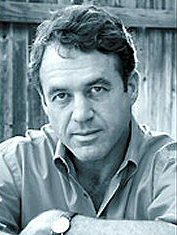

American Ground author William Langeweische; one of the versions of the cover.
The Columbia film was reported about in a 2.1.05 Variety article by Mike Fleming and Nicole Laporte. (The link is impossible.) It will be produced by Mike DeLuca, Rachel Horovitz and Michael Jackson.
Variety has also reported that Imagine honcho Brian Grazer has a deal with NBC Universal TV for an eight-hour miniseries based on the 585-page 9/11 Commission Report.
But it’s looking like the Jimeno-McLoughlin story could be the opener — Hollywood’s first 9.11 dramatization/recreation to hit screens nationwide. And given what it is (or appears to be), I find this disappointing.
That’s because it doesn’t have anything like the surreal, full-throttle, hand-of-God quality of what happened to Buzzelli, who somehow wasn’t crushed or otherwise killed when the North Tower collapsed, but instead landed on a concrete slab 180 feet below and was later found and carried off by rescuers.
Remember that urban myth that went around just after 9/11 about some guy (a fireman, the rumors said) who had somehow surfed the collapse of one of the buildings from one of the highest floors and miraculously made it to the ground alive?

Retired Port Authority officer John McLoughlin with 60 Minutes reporter Vicki Mabrey during visit to Ground Zero.
Snopes.com, a smart urban-myth-debunker site, discusses the “building surfer” myth as follows: “Because this is a rumor of man triumphing over mayhem, lore remakes one of the cherished but doomed heroes of [9/11] into a survivor, changing his real fate into one that not only spares his life, but leaves him triumphant in the face of utter devastation. Our sense of justice is thus appeased.
“He’s a figment of our wishful imaginations, a fictional icon of indomitability we are quick to turn to in times of disaster. In our minds, we see his ride as a giant thumbing-off to the destruction raining down about him.”
My point is, Buzzelli was almost this guy.
Buzzelli’s wife Louise, whom I spoke with briefly this morning, says her husband “landed on top of where [Jimeno and McLoughlin] were. They were in this void, this pit, and Pasquale actually landed right on top of them. The rescue workers found the other two first and told Pasquale, ‘Hang tight, we’ll be back to get you.’ They thought he was a rescue worker, and then one of them finally said, ‘Holy shit, this is a civilian.’ They had no idea.”
In September 2002 I excerpted an extremely well written Atlantic Monthly article that told Buzzelli’s story. The author was William Langeweische, in the second of two articles (called “The Rush to Recover”) about the disaster and its aftermath.
There are no online links, but all of Langeweische’s aftermath-of-9/11 reporting was published in a book called “American Ground: Unbuilding the World Trade Center.”

Here’s a transcript of Langeweische relating Buzzelli’s story for a PBS documentary about 9/11.
I love Pasquelli’s story because it says that God or fate or whatever can sometimes show random compassion and make senseless exceptions in allowing this or that person to duck out the back door. I love the sheer exhilarating illogic of a guy being in a huge collapsing building and falling that far and coming out of it with just a few broken bones and bruises.
On top of which Buzzelli went through a phase after his brush with death that was not unlike the emotional journey taken by Jeff Bridges’ character in the 1993 Peter Weir film, Fearless .
Instead of feeling elated over having survived, Buzzelli felt guilty and was plagued by nightmares. He wound up spending several months in a TV-watching, weight-gaining funk. His story was told in a September ’03 New York magazine piece (“The Miracle Survivors”) by Jim Fishman.
I think that Buzzelli’s surviving the North Tower collapse is on the level of that guy bursting out of the bathroom in Pulp Fiction and blasting away at point-blank range at Samuel L. Jackson and John Travolta…and neither one getting hit.
There were 16 survivors who were on the stairwell when the North Tower collapsed who made it out alive. Fishman doesn’t mention Jimeno and McLoughlin in the piece, but it would be surprising if they didn’t experience some psychologically tough patches of their own. Maybe their experience with this will be woven into the Shamberg-Sher film…or not.
I just know I’d much rather see the Buzzelli story on a movie screen. There’s that hand-of-God element, and the second act out of Fearless…and I can’t help but imagine how stunning it would be to see a recreation of what this poor guy went through. It would be (how could it not be?) an aural-visual mindblower.
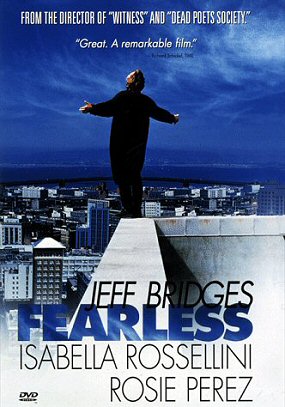
Here’s how Langeweische described it:
“Buzzelli had just passed the 22nd floor when the North Tower gave way. It was 10:28 in the morning, an hour and 42 minutes after the attack. Buzzelli felt the building rumble, and immediately afterward heard a tremendous pounding coming at him from above, as the upper floors pancaked. Buzzelli’s memory of it afterwards was distinct. The pounding was rhythmic, and it intensified fast, as if a monstrous boulder were bounding down the stairwell toward his head.
“He reacted viscerally by diving halfway down a flight of stairs, and curling into a corner of a landing. He knew the building was failing. Buzzelli was a Catholic. He closed his eyes and prayed for his wife and unborn child. He prayed for a quick death.
“Because his eyes were closed, he felt rather than saw the walls crack open around him. For an instant the walls folded onto his head and arms, and he felt pressure, but then the structure disintegrated beneath him, and he thought, ‘I’m going,’ and began to fall. He kept his eyes closed. He felt the weightlessness of acceleration. The sensation reminded him of thrill rides he had enjoyed at Great Adventure, in New Jersey. He did not enjoy it now, but did not actively dislike it either. He did not actively do anything at all.
“He felt the wind on his face, and a sandblasting effect as he tumbled through the clouds of debris. He saw four flashes of light from small blows to the head, and then another really bright flash when he landed. Right after that he opened his eyes, and it was three hours later.
“He sat up. He saw blue sky and a world of shattered steel and concrete. He had landed on a slab like a sacrificial altar, perched high among mountains of ruin.
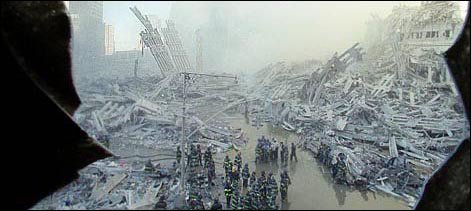
“There was a drop of fifteen feet to the debris below him. He saw heavy smoke in the air. Above his head rose a lovely skeletal wall, a lacy gothic thing that looked as if it would topple at any moment. He remembered his fall exactly, and assumed therefore that he was dead.
“He waited to see if death would be as it is shown in the movies — if an angel would come by, or if he would float up and see himself from the outside. But then he started to cough and to feel pain in his leg, and he realized that he was alive.”
On the PBS documentary, Langeweische said at this point that Buzzelli was “lying on this altar. There’s no one around. It’s utterly silent. There’re no people around, nothing. It’s a wasteland desert in the middle of New York City. The buildings are gone, there’s smoke, and then there’s fire.
“At some point, he was quite certain — to make a long story short — that he was going to die from fire. So certain that he found a piece of jagged metal and was going to cut his wrists, in order not at least to burn to death. And he had gotten to that point when he was rescued.”

Film industry reporters (and their editors) love writing about how this or that middle-aged corporate white guy has come into power, and what they’ll do when they start using it. (Or how they lost their grip on it.) Disney’s Bob Iger, the guy taking Michael Eisner’s place, is the current topic. Last week it was Howard Stringer becoming the first non-Japanese Sony CEO. The Weinstein brothers had the heat in February for concluding contractual talks about relinquishing Miramax to Disney, and announcing their plans to start a new operation. Paramount’s Brad Grey was the guy in January…and believe me, nobody outside of a small New York-Los Angeles clique cares. Because corporate white guys don’t affect the movies — filmmakers and their producers do. Brad Grey and his boss, Tom Freston, are, in some ways, going to make Paramount Pictures more of a go-getter operation than Sherry Lansing’s Paramount was…fine. And there’s a certain fascination in the drama of corporate samurais acquiring and losing power. But they’re all the same white guy to me…different faces, same suits, slightly different haircuts…each serving the same sociopathic corporate goals. CWG’s come and go, and the only people who perk up and say, “Look…a new CWG has replaced the previous CWG!” are these reporters, their editors and publishers, and a small elite readership (i.e., regular readers of Variety, Wall Street Journal, Forbes, etc.) “Maybe [Iger] really has a vision for the future that Michael Eisner hasn’t seen,” David Poland wrote the other day. “Of course, even if he does, he has another problem: no one is anticipating real change under Iger.” Uhh…David? No one anywhere anticipates real change from any CWG, ever. They couldn’t be more interchangable.
“In a couple of days throngs of movie theater owners and managers will descend on Las Vegas for four days of schmoozing, a smattering of screenings, a Mobius strip of meals and receptions, seminars and sundry other activities. It’s called ShoWest”… and most of these exhibition guys will be secretly miserable, because Vegas is the worst money-grubbing place in the world and the vibes are seriously awful. Unless you’re someone like Len Klady, it’s a tolerable environment for roughly four to six hours and then it’s agony…all you want is to leave and never come back.
Too Fast Farewell
It can sometimes take a while — two or three days, I mean — for the real soul of a place to be felt.
I’ve met several more good people at the Mar del Plata Film Festival since arriving here last Thursday evening (and composing Friday’s column, which took a while), and the warmth — not just the efficiency or commitment to the staging of a first-rate event — has been seeping through.

Close to the beach in Mar del Plata — I know not specifically where.
Of course, a visiting Hollywood journalist would be treated with all kinds of caring and graciousness. I’m speaking of something beneath this.
It would be facile to try and sum up Argentina’s basic attitude in one or two sentences, but Ines Vionnet, a whip-smart Buenos Aires woman who translated my comments during Saturday’s “master class” with Hugh Hudson, seemed to put her finger on something when she told me last night, “This is a sad country.”
In some ways, Argentina is Europe of a different latitude. Things have been hard here economically (the peso devaluation of late ’01 was devastating), but I’m not feeling much depression or bitterness from anyone. I’m getting more of a world-weary positivism, if that makes any sense. One day at a time, comme ci comme ca, life is what you make it. I’ve been speaking only with artist or professional class types, of course, but my four days here have reminded me that laughter in the wake of hard times means a lot more than the usual kind.
< ?php include ('/home/hollyw9/public_html/wired'); ?>
A special thanks to Angeles Anchou, who served as my “angel” (a festival term for someone who facilitates, translates, gets you into parties). And also to Tomas Posse, a young cinematography student who handled the DVD clips during the Hudson seminar. (Tomas was very upset when he lost his notes for the clip cues just before we started, but the presentation came off fine regardless — he proved himself a pro under pressure.)
And a heartfelt thanks to Miguel Pereira, the festival’s affable and gracious president, for having me here and taking the time to make me feel welcome and appreciated, and also for introducing me to the beautiful Esther Goris, who played the charismatic lead in Juan Carlos Desanzo’s Eva Peron (1996), which was billed in some quarters as “Argentina’s answer to Evita !”
Dylan Kidd, the director of P.S., a competition entry, was hanging around the Hermitage bar and in fairly good spirits. Ditto director Luis Mandoki (Voces Inocentes), whom I didn’t speak to. Federico Luppi, whose performance as an elderly vampire in Guillermo del Toro’s Chronos has never left me, was here and there, but I didn’t say hello to him either, mostly out of embarrassment over my lousy Spanish.
I’m off to the airport in an hour or so. I’ll have about six hours to wander around Buenos Aires (Nine Queens director Fabian Beilinsky has suggested a couple of excellent restaurants in the San Telmo district) before flying back to Los Angeles late this evening.
Beaten, Bruised, Hurting
No, not me. I’m relatively fine. I’m talking about the people of Argentina, or at least how they’ve recently been portrayed.
I’m basing this observation on descriptions of recent and noteworthy local films that I read about in a catalogue during a Thursday afternoon bus ride from Buenos Aires to Mar del Plata.
There are films being made in Argentina these days that strive to entertain. The usual sex comedies, romantic whimsy films, youths-experimenting-with-this-or-that films, child-rearing dramas, tango movies…whatever. But social realism is the burn-through right now.

Avenida Nueve de Julio in Buenos Aires — Thursday, 3.10.05, 11:45 am.
Of the 86 films listed in the 2004-2005 Cine Argentino catalogue, there are 34 or 35 that are specifically about (or were largely inspired by) two social traumas that have had devastating impacts — the political atrocities and murders carried out by Argentina√ɬ¢√¢‚Äö¬¨√¢‚Äû¬¢s military dictators from ’76 to ’83, and the foreign-loan default and currency devaluation of late ’01, a kind of economic 9/11 that decimated living standards and brought despair and depression into tens of millions of lives.
Of these 35 films, ten are focused on or inspired by the dictatorship and the “disappeared,” and 25 are about the agony and hopelessness that comes from poverty and being jobless and having little if any prospects. They√É‚Äö√Ǭ¥re mostly straight dramas with docs here and there, but altogether we’re talking about a world of hurt.
Painful stories are always more involving than stories that avoid this, or go in the opposite direction. As callous as it sounds, difficult and/or traumatic times tend to produce better films.
Argentina√ɬ¢√¢‚Äö¬¨√¢‚Äû¬¢s only success at winning a Best Picture Foreign Film Oscar was The Official Story (’85), about an investigation into political murders by the military junta and their political allies in the Argentine government. (In fact,Story is the only Latin American film to win in this category.) Maybe a film dealing with the financial catastrophe will be the next one to register.
Here are some passages from the synopses for these 35 films, all of which convey the general notion that life in Argentina has been terrible or damn close to it:

Take-out delicatessen near Mar del Plata. Divide the prices by three, and that’s your cost in dollars.
“In a country corrupted by poverty…” (from a synopsis of Eduardo Pinto√ɬ¢√¢‚Äö¬¨√¢‚Äû¬¢s Palermo Hollywood ).
“In the ’76 to ’83 period, thousands were kidnapped and murdered with absolute impugnity…[and] new-born babies of women pregnant at the time of their abduction were illegally taken away and adopted by other people. The disappearance of [these] children is one of the darkest legacies of this period.” (from a synopsis of Benjamin Avila√ɬ¢√¢‚Äö¬¨√¢‚Äû¬¢s Nietos (Identidad y Memoria ).
“Through all this time, the majority of the population had to survive below the poverty line, and marginality and unemployment grew at an accelerated rate, while politicians concocted obscure plans to cover the fact that the foreign debt was the cause and affect of an almost bankrupt coun try” (from a synopsis of Diego Musiak’s La Mayor Estafa al Pueblo Argentino).
Paula, a Buenos Aires actress, “wakes up one day and finds out her gas service has been cut off due to lack of payment. [And then] her boss fires her, the landlord threatens to evict her since she is four months late with the rent, her bank account balance is in the red, her father and friends refuse to help her, and even the director of a play she√ɬ¢√¢‚Äö¬¨√¢‚Äû¬¢s in offers an indecent proposal.

Movie poster in central Buenos Aires — Thursday, 3.10.05, 11:05 am.
“What follows is an odyssey which drives a typical middle-class woman to relinquish her innocence, sink into a sordid Buenos Aires, and discover a universe not as safe as it once seemed to be.” (from a synopsis of Alejandro Chomski√ɬ¢√¢‚Äö¬¨√¢‚Äû¬¢s Hoy y Manana).
“Bernardo is 50. He feels overwhelmed, confused and almost devastated by a society that is, little by little, falling to pieces” (from a synopsis of Luis Barone√ɬ¢√¢‚Äö¬¨√¢‚Äû¬¢s El Tigre Escondido).
“These are good, hard-working, desperate men tyring to overcome the despair generated by unemployment and to rebuild their lives, but their efforts crash against the crude reality, which seems to keep pushing them to the edge” (from a synopsis of Nicolas Tuosso√ɬ¢√¢‚Äö¬¨√¢‚Äû¬¢s Proxima Salida).
“The documentary reviews the 1976-2001 period, depicting the economic, social, political and moral decadence of those years in Argentina…[and explores] what this battered South American country√ɬ¢√¢‚Äö¬¨√¢‚Äû¬¢s inhabitants, always ready to put up a fight even against the most catastrophic developments, had to go through” (from a synopsis of Fernando Solanas√ɬ¢√¢‚Äö¬¨√¢‚Äû¬¢s Avila√ɬ¢√¢‚Äö¬¨√¢‚Äû¬¢s Memoria del saqueo ).

Buenos Aires street — Thursday, 3.10.05, 10:50 pm.
Estoy Aqui
There’ll be no summing up the essence of the Mar del Plata Film Festival in this column, or even a stab at a semi-comprehensive overview. Not after what I’ve been through over the last 40 hours, which has put me in a fatigued and grimy mood.
I guess this was in the cards when I knew I’d be flying 6100 miles one-way.
I√ɬ¢√¢‚Äö¬¨√¢‚Äû¬¢ve been sniffing things out since pulling into this Argentinean resort town last night around 7 pm…”sniffing” being a euphemism for not really getting into it and hanging back and scowling with a drink in my hand and leaning against walls.

View of Atlantic Ocean from sixth-floor hotel room at the Hermitage in Mar del Plata — Thursday, 3.10.05, 7:45 pm.
I’d never heard of this festival until Phillip Noyce (The Quiet American, Rabbit Proof Fence) turned me on to it a couple of months ago. (He was here last year.) It’s very well-run and tastefully programmed, and, in my judgment, as “good” of a film festival as Karlovy Vary or Locarno or San Francisco.
I guess the festival organizers flew me down here so I’d pass the word along to the Hollywood community that it’s cool to visit and that the vibe is all right. Yes, this is so. The people behind the Mar del Plata Film Festival are committed and energetic and as much in love with film as Tom Luddy or Geoff Gilmore or anyone else in the film festival universe, and you can feel this we-really-and-truly-care vibe everywhere you turn.
The festival website, the festival-at-a-glance brochure, the daily printed schedules, the publicity element…it’s all totally first-rate.
I’m just not feeling huge electrical currents so far. I thought I might luck onto some bat-out-of hell Argentinean film that everyone will be clamoring to see when it plays at Tellruride or Toronto six months from now, but I don√ɬ¢√¢‚Äö¬¨√¢‚Äû¬¢t know what this film might be might be since no one from the festival is telling me anything, and I’ve been too shagged to ask.
Clenched
I’ve been in a place between fuming and despair for the last twelve hours or so. I’m delighted, actually. I just like to hide my feelings when I√ɬ¢√¢‚Äö¬¨√¢‚Äû¬¢m feeling good. Late last night I donated my $400 digital camera to some Mar del Plata citizen, and I just want to go out on the streets and give the world a big hug.
I donate valuable possessions whenever I’m really tired. My brain stops working and I start forgetting.

One of the last photos taken on my disappeared Fuji digital camera.
Sometime between my sitting in an Italian restaurant right around the corner from the Hermitage hotel (a superb five-star operation and the headquarters for the festival) around 11:45 pm and walking into my hotel room five or ten minutes later, the device was left behind and the new owner was rejoicing.
Ten minutes later, he/she was starting to take shots and try out different exposure settings.
The only way I can stop feeling angry is to take a Born Into Brothels attitude and hope that some poor teenage kid (or the parent of one) found it and this will lead to the young person discovering he/she has real potential or talent as a photographer, etc.
Trip
It took fifteen and a half hours to fly to Buenos Aires from L.A., for which I blame Delta Airlines because they take you all the way to Atlanta before heading south.
I would have much preferred flying straight to Panama City, say, and stretching my legs for an hour or so and then going from there. I left LAX on Wednesday at 12:30 pm, and arrived Thursday about 9 am, or 4 am L.A. time. (Buenos Aires is two hours later than Atlanta and New York.)
I ran into producer Lawrence Bender (Pulp Fiction, From Dusk to Dawn) at the luggage carousel. The Mar del Plata festival is giving him an award on Sunday, and making him the focus of a “master class” interview on Saturday. Bender stayed in town on Thursday to night to celebrate the opening of a friend’s hotel.
And then Gabriela, an extremely bright volunteer from the Argentine Film Institute, gave me a ride into town and took me to the institute’s offices where I left my bags so I could walk around Buenos Aires a bit, which I did for a couple of hours.

Buenos Aires street — Thursday, 3.10.05, 12:55 pm.
Buenos Aires didn√ɬ¢√¢‚Äö¬¨√¢‚Äû¬¢t give me one of those “I really love it here” feelings, to be perfectly frank.
It’s generally acknowledged as a great city and all, but that’s about the people and the culture and the teemingness of it. The city itself is big and flat and endlessly sprawled…miles upon miles. It smells to me like the air has an inordinate amount of pollution. The streets feel hot and vaguely oppressive — not enough fresh air, moisture oozing out — everywhere you go. I saw a lot of weary expressions on a lot of faces.
Bureaucratically-speaking, Argentina is one of those horrid places in which doing things very thoroughly (a polite term for “very slowly”) and filling out forms is either a matter of national pride, or an example of people having been beaten down and Kafka-ized into pulp. Stuff takes a long time to figure out or get done, and you’re always being asked to fill out a form, or being handed one. It’s like Soviet Russia.
I waited at a bank to change some dollars into pesos and it took over 20 minutes to get to a teller. Then the teller said no currency exchange because I didn√ɬ¢√¢‚Äö¬¨√¢‚Äû¬¢t have my passport. (If it’s just cash, why should anyone care?) I went back and got the passport and then waited in line another 15 or 20 minutes, and then the teller made me fill out a form before giving me the 400 pesos.

Cluster of businesses in southern neighborhood of Buenos Aires, on the way out of town.

Road sign about 30 kilometers outside Mar del Plata.
But the exchange rate is great here (i.e., bad for Argentinians, good for Americans).
You can use a computer at an internet café for a full hour for only 2 pesos, or about 70 cents. Beers at a pricey hotel bar in Los Angeles or New York are at least five or six bucks, but here they’re four pesos, or about $1.40. That Italian meal I had last night just before losing my camera only ran me about 15 pesos, or a little less than six dollars.
The power of the American dollar has been destroyed by the huge Bush deficit. Euros cost about $1.32 now, which is way higher than they’ve ever been. It shows you how completely de-valued the Argentinian peso is when even the crummy dollar has serious buying power here.
A woman who works for the festival told me that even the Nicaraguan economy is doing better than Argentina’s at this stage. She also told me her monthly salary comes to about $300 U.S. She shares an apartment in Buenos Aires with another woman, she said, for which the rent is the equivalent of $275 U.S. monthly.
The area of Argentina from the airport north of Buenos Aires to Mar del Plata is totally flat. I√ɬ¢√¢‚Äö¬¨√¢‚Äû¬¢m told there are other portions of the country with contour, but the part I was driven through yesterday was like southern New Jersey, Wisconsin, Texas. Not the slightest mound or gulley or sinkhole anywhere…until I got to Mar del Plata, which has a hilly area close to the beach.
The double-deckered bus from Buenos Aires to Mar del Plata has big, cushy, sofa-like seats, as nice as the ones in the first-class section of 747s or 767s. I slept like a rock.

Melanie Griffith in A Stranger Among Us, as seen on 17″ screen on the double decker bus from Buenos Aires to Mar del Plata.
And the TV monitors actually work and have programming, which the monitors on U.S. buses never do. It’s a very weird thing to wake up from a long nap and see Melanie Griffith playing a cop in A Stranger Among Us on a little TV screen, with Spanish subtitles, just above your seat.
The waves are very slight in front of the Hermitage Hotel on Mar del Plata beach. The Atlantic Ocean here is almost like one of the Great Lakes, or the Long Island Sound off the coast of Connecticut.
Don’t get me started on my Mar del Plata computer problems.
The broadband hookup in the hotel room won√ɬ¢√¢‚Äö¬¨√¢‚Äû¬¢t work for my Toshiba laptop (I’m being told it’s my computer’s fault, even though the computer and I have been online with all kinds of plug-ins and dial-ups and wireless devices).

Festival “angels” who picked me up at Mar del Plata bus station and drove me to the hotel.
Since none of the computers at the internet cafes are new enough to read information off a USB data plug-in thing (they don’t even have the receptacles), I’m forced to file in the press room downstairs between the hours of 9 am and 6 pm, which sucks.
It’s impossible to figure out how to type the “@” sign on an Argentinian keyboard — someone has to show you. The “@” sign shares the number 2 key, but this key is a red herring…just something to throw you off. You have to press down the ALT key and then type 6 and 4, but not the ones on the top keyboard row. You have to type the 6 and 4 that are part of the far-right keyboard cluster.

Subway stop near Avenida Nueve de Julio in Buenos Aires — Thursday, 3.10.05, 12:40 pm.

Posters on Avenida Nueve Julio.

State of Siege
I’ve been thinking and calling around about Steven Spielberg’s “Untitled Munich Project” for the last couple of days, and decided it’s in the cards for it to be something more than a revenge flick. I’m thinking it pretty much has to be.
It’s about the 1972 murders of Israeli athletes during the Munich Olympic games, partly…but mainly the response to this atrocity by Mossad, or Israel’s CIA. And the moral and ethical mucky-muck that results, I gather.

A member of Black September standing on balcony of Israeli athletes’ condo in Munich’s Olympic Village during September 1972 hostage stand-off.
This will be the heart of it, I presume. It can’t just be a Black Sunday-like piece about killing Palestinian terrorists. It might be this, I suppose, but I can’t see the humanist New York playwright Tony Kushner (Angels in America ) writing a get-the-bad-guys procedural. Can you?
That recent rumor about the Munich project having a working title of Vengeance isn’t true, but it explains why some people are thinking it’s about payback.
< ?php include ('/home/hollyw9/public_html/wired'); ?>
This will be Spielberg’s second major-league feature having to do with lethal aggression against Jews, the first being Schindler’s List, and he knows this latest effort will be compared to his 1993 Oscar winner, so he’s got to…you know…make it complex, high-minded, morally probing.
Spielberg and his team will be shooting the Munich project in various European and Middle East locations starting in late June (just as Spielberg’s War of the Worlds opens worldwide, on 6.29), and Universal is planning to open it on 12.23, in a clear angling for Oscar gold.
I’m guessing it’ll be a super-charged, early-William Freidkin thriller about the futility of seeking revenge, with a theme that says, in so many words, “If we all keep taking an eye for an eye, pretty soon the world will be blind.”
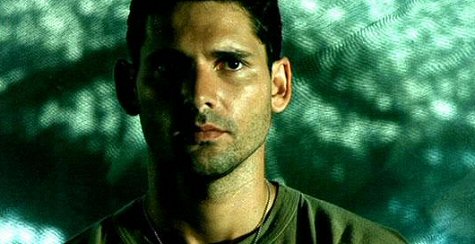
Eric Bana
This line comes from a 1986 TV movie, Sword of Gideon, which was based on the same true-life story the Spielberg-Kushner film is apparently about.
Spielberg’s spokesperson Marvin Levy will only say it’s about the “aftermath” of the ’72 killing of 11 Israeli athletes during the Munich games by the Palestinian terrorist group called Black September.
Two athletes were killed during a hostage-taking and stand-off situation with German authorities at Munich’s Olympic village. Nine more were killed by a grenade blast at Munich’s Furstenfeldbruck airport when authorities tried to shoot it out with the terrorists.
I haven’t read Kushner’s script, but one of the film’s vantage points is that of “Committee X,” a high-ranking group of Israeli officials, chaired by Israeli premiere Golda Meir and Defense Minister Mosha Dayan, and the assassination campaign they ordered Mossad to carry out — to murder every strategist and supporter known to have in some way supported Black September’s Munich operation.
The operation was known in some circles as Operation Wrath of God.
The idea behind the campaign, which was known as the kidon (Hebrew for bayonet) and run by senior Mossad agent Mike Harrari, was to strike terror in the hearts and minds of the plotters. It was primarily for the sake of revenge, I’m sure, but also to try and psychologically deter similar operations.

Remnants of charred helicopter at Munich’s Furstenfeldbruck airport, on the morning after the killings of nine Israeli athletes.
Mossad started with a list of 11 names, but the people they wound up killing numbered 18, by one count.
Harrari’s plan was to be absolutely precise and avoid collateral damage, and yet people who had nothing to do with the Munich killings — a Moroccan waiter, a Russian KGB agent, an Arab-looking bodyguard in Gibraltar, three Arab-looking guys who made the mistake of pulling out guns during a raid in Switzerland — died at the hands of the kidon killers. Seven in all.
Were some of these people innocent? One was, and some of the others may have been.
The Harrari figure was called “Avner” in Sword of Gideon, and was played by Steven Bauer (Traffic, Scarface). It appears that Eric Bana (Troy, The Hulk), who’s been cast as the lead in the Spielberg film, will play Harrari, or a character based upon him. (Levy told me he’s not playing a Black September guy, so that narrows it down.)
The IMDB says Daniel Craig (Layer Cake, Undying Love) has also been cast. (Probably as one of the villains, right?) The usual Spielberg team — producer Kathy Kennedy, dp Janusz Kaminski, editor Michael Kahn, composer John Williams — have signed on. (Williams worries me. His music could have a gauzy effect.) Barry Mendel is also producing.
Eric Roth (The Insider) and Charles Randolph (The Life of David Gale ) worked on the Munich project before Kushner came aboard (I think) sometime last year.
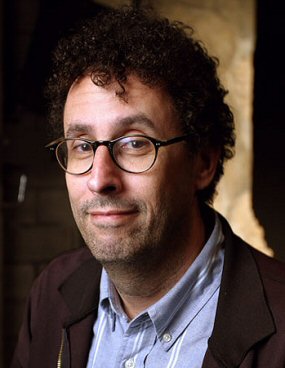
Untitled Munich Project screenwriter Tony Kushner
Art is in no way obliged to tow the current political line, but I wonder what impact, if any, the Munich project may have upon the political ebb and flow, especially if it turns out to be good and popular and deserving of awards.
There’s been some movement in the Israeli-Palestinian peace process lately, especially since the death of Yassir Arafat, with Israel giving back territory and whatnot. And the Munich movie could, at least in terms of the straight action elements, revive feelings of hate in certain quarters.
I would assume that Spielberg and his crew will have to be fairly careful with security issues when they’re shooting this summer, especially in the Middle East.
“What I find interesting about this is that it seems simple on its face…a good and evil story,” said Democratic strategist and West Wing consultant Lawrence O’Donnnell.
“This is not something anyone can predict, but I’m sure Tony Kushner will find the complexity in the story. I don’t think it would be premature to have an expectation for something great here. This will not be Raid on Entebbe.”
“Steven was pretty clear even last year that he did not want any preconceptions about what this [film] would be,” Levy said yesterday.
I know, I know…I should just shut up until someone slips me a copy of the script.

If You’re Interested…
There’s a pretty good blow-by-blow about the Munich murders and the Mossad revenge on a website called Special Operations.com. Here’s the link .
The mini-history, written by Thomas B. Hunter, is based on a book by Alexander Calahan called “Countering Terrorism: The Israeli Response to the 1972 Munich Olympic Massacre and the Development of Independent Covert Action Teams,” (Marine Corps Command and General Staff College, April 1995).
Quickies
You have to hand it to Spielberg this year — he’s really kicking ass with the finishing of the visually revved-up War of the Worlds (Martian space ships…c’mon), and then shooting, editing and wrapping the Munich project in just six months…July to December.
And then right into that Liam Neeson Abraham Lincoln biopic, right? I can’t wait for that one. Neeson will kill as Honest Abe.
When I say fast shoots I really mean fast post-production periods. I can only think of three or four off the top of my head.
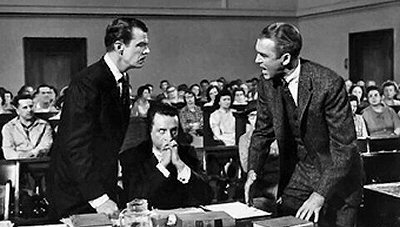
James Stewart (right) and Goerge C. scott (seated) in Anatomy of a Murder.
Million Dollar Baby, of course, began shooting in the summer of ’04 and was done by last November. Remember that Spielberg put both Jurassic Park and Schindler’s List into theatres, so I guess the latter was a fairly fast one.
For some reason I recall that the making of Floyd Mutrux’s American Hot Wax (1978), was fairly fast, or at least was in theatres only three of four months after finishing principal photography.
The fastest big-studio movie I’ve ever read about was Otto Preminger’s Anatomy of a Murder (1959), the Jimmy Stewart courtroom drama. According to the liner notes on the DVD, Murder shot for eight weeks and wrapped on May 15, 1959. It opened in big-city theatres about six weeks later, on July 2nd.
Cowards
Andy and Larry Wachowski have gotten so caught up in their hiding-away syndrome that they’re producing V for Vendetta, an apparently thoughtful, Matrix-resembling action drama they wrote and developed years ago, rather than expose themselves to the threatening immediacy of being on the set and yelling “action!” and “cut!” and dealing with grips and best boys.
In their place, they’ve hired a talented flunky — James McTiegue, who worked as first assistant director on the Matrix trilogy — to “direct” the film. This strategy will allow the brothers to give McTiegue guidance (i.e., explain exactly what to do) as they keep a watch on things, perhaps from some heavily-fortified cyber-bunker several hundred feet below the streets of Berlin.
V for Vendetta is about to start shooting for ten weeks or so in Berlin.
The Wachowski’s will never be free from the fish net of their own making until they drop the super-secretive routine and stop cowering and “come out” and embrace (or at least accept) the occasionally rude and insensitive rough-and-tumble of the business, including dealing with the press and walking down streets and going into drugstores to fill their own prescriptions.
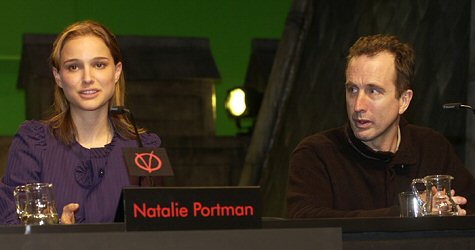
V for Vendetta star Natalie Portman and director James McTeigue at last week’s press conference in Berlin.
Larry can wear anything he wants and be anyone he wishes to be, but the boys can’t be Glenn Gould or Thomas Pynchon any longer. After a certain point the hiding of one’s face becomes tedious.
V for Vendetta, a tale about violent revolution in a futuristic London under the boot of a totalitarian government, is being filmed in Berlin with Natalie Portman in the lead role of “Evey.” Unfortunately, Portman will be losing weight and shaving her head for the role. James Purefoy is costarring.
The story is about “the people” helping to bring down an oppressive government, with Evey being a sort-of terrorist type with an ambiguous strain — i.e., is she good or bad or…?
“It√ɬ¢√¢‚Äö¬¨√¢‚Äû¬¢s a very human story and because it√ɬ¢√¢‚Äö¬¨√¢‚Äû¬¢s human it√ɬ¢√¢‚Äö¬¨√¢‚Äû¬¢s not black and white,” Portman said at a Berlin press conference last week. “It is much more complicated and ambiguous than one person is good, one person is bad, the government is good, the people are bad, or the government is bad the people are good…it√ɬ¢√¢‚Äö¬¨√¢‚Äû¬¢s a lot more complex.”
Silver was asked about the Wachowskis’ game plan and general reclusiveness.
“When they wrote the script it was before they had directed anything, so maybe they were thinking at some point they would [direct it],” he answered. “Their intention following The Matrix was to take some time off from directing so they√ɬ¢√¢‚Äö¬¨√¢‚Äû¬¢re producing the picture with us.”
The Wachowskis were last seen by the public in the summer of ’03 when Matrix Reloaded opened to vague and then growing disappointment, and they damn sure haven’t been seen since Matrix Revolutions opened later that year and the whole mythology came crashing down in an anguished heap, with the spirit of the first Matrix film having been totally abandoned and traded in for something else.
“They√ɬ¢√¢‚Äö¬¨√¢‚Äû¬¢re here [in Berlin] and they√ɬ¢√¢‚Äö¬¨√¢‚Äû¬¢re very involved and they√ɬ¢√¢‚Äö¬¨√¢‚Äû¬¢re kind of support for James and they√ɬ¢√¢‚Äö¬¨√¢‚Äû¬¢re very anxious for James,” Silver said about the brothers.
They may be anxious about James McTeigue, but the plan is not fundamentally about supporting him or even his gifts as a director — the plan is about Larry and Andy needing to work in the shadows.
Their screenplay is based on the V For Vendetta graphic novel by Alan Moore and illustrator David Lloyd, which was originally published by DC Comics as a ten-part series in 1988.
Warner Bros. will open V For Vendetta on 11.4.05.
Stand Back
Believe it or not, I’m on my way to Argentina today (Wednesday) and the Mar del Plata Film Festival, where I’ll be poking around for a grand total of four days.
The festival organizers have invited me down to cover, and to also moderate a “Master Class” session on Saturday with director Hugh Hudson (I Dreamed of Africa, Chariots of Fire, Greystoke). I’ll run some photos and whatever stories I can come up with.

I’m also going to work in an exploration of Buenos Aires for a few hours on Sunday. When opportunity knocks, it’s usually a good idea to grab it. I would never have managed a trip down there on my own dime. I’ve never really wanted to, I mean.
Any Argentinan journalists or filmmakers who may be in Mar del Plata for the next few days are invited to get in touch. I’d like to know what’s doing.
I wonder if Fabian Beilinsky, the director of Nine Queens whom I met in Toronto two or three years ago, will be in the neighborhood?
Poet’s Return
I had to shut down the chat room after getting hacked twice over the Christmas holidays, but we have a new server now and new composing software (i.e., Movable Type), and I’m told by Brian Walker, Hollywood Elsewhere’s Man in Ohio, that the message boards and maybe even a chat-room screen will be back up by the end of the week.
I hope everyone gets into the habit again. I’ll do what I can to visit more often and get involved with whatever’s being chewed on and batted around.

Sorry for taking the thing down but getting hacked like that was awful…awful….and chat rooms are the most vulnerable spot in a site like this, and I didn’t want to risk any further invasions.
There’s also a new column coming soon by Sweden’s Nic Kockum (there’s been talk about calling it “Viking Gangbang”) and an L.A. socio-political industry column by the great Flint Wainess, a screenwriter and founder of the always fascinating www.breakupnews.com.
Dreams May Come
The shooting and projecting of movies on 35mm film is a dying practice, and it won’t be long before everything is digital this or that…no argument there.
But when will digital projection really be here, and from what digital source or delivery system will movies be obtained and projected — satellite transmission, fibre optic cable, pirate-proof DVDs?
I don’t know how long it will all take, but probably a while. Five years, ten years. Big changes in the way things are done never happen until economic conditions demand them…until the captains of industry feel the flames licking their feet.

But while we’re waiting and trading scnearios, here’s one that’s been passed along that’s more diverting than most. Some of it is fact, the basic thrust of it seems sensible, and the parts that aren’t verified or have been denied seem…well, intriguing. And digging it all up and learning a bit about the world of digital tomorrows was fun.
It involves Regal Entertainment, the 6,273 screen chain composed of Regal Cinemas, United Artists Theatres and Edwards Theatres, and a purported, unverified but logical-sounding plan said to be under consideration by the chain’s owner, reclusive Denver billionaire Phillip Anschutz, to move a significant portion of Regal into a sophisticated digital projection mode.
< ?php include ('/home/hollyw9/public_html/wired'); ?>
The scenario, which has been derided as “conjured,” “colorful,” “nonsense” and having “no basis in fact” by Anschutz’s spokesperson Jim Monaghan, is two-fold — partly about a new middle-American, family-values digital distribution network that may be in the offing, and partly about a nationwide fibre-optic delivery system for films to be shown digital in theatres.
The technical speculation is that movies (in the form of digital feature-film data) could theoretically be sent from a digital switching center (possibly from the St. Louis headquarters of Qwest, the phone company owned by Anschutz) over a vast network of fibre optic cable that’s been laid down by Anschutz alongside the tracks of his Union Pacific railroad company, which he also owns. The films would then be relayed to Regal theatres, booths and projectors and thereby projected.
In so doing, the theory goes, Anschutz would become not just a major digital distributor of movies (through Regal Cinemedia, the division of Regal that attends to the digital potential side) but also, producing-wise, a major market force for G and PG-rated films through Anschutz’s two production companies, Bristol Bay and Walden Media.
Anschutz, in short, would one day be the Big Kahuna of not just a digital-projection empire, but the driver of a kind of ideological market force that, in part, would deliver family-friendly films produced by the Anschutz Film Group, the parent of Bristol Bay and Walden Media.

An indicaton of Anshutz’s game plan lies in the fact that he financed Taylor Hackford’s Ray to the tune of $35 million, but only upon an insistence that Hackford deliver a PG-13 film.
As Associated Press reporter Sandy Shore reported on 2.27, “Anschutz is a devout Presbyterian, but associates say he doesn’t try to influence projects with his beliefs.” Hackford told Shore he and Anschutz “disagreed” about the PG-13 rating, but once Hackford backed off from wanting to possibly deliver an R-rated film, Anschutz “left him alone to make the film.”
“He’s a conservative Republican and he knows I’m a liberal Democrat,” Hackford told the reporter “That didn’t mean we couldn’t talk about business.”
The technical speculation is that Anschutz has a contingency plan to eventually bring cinema-grade digital projection (i.e., with a 2K capacity, in keeping with today’s higher standards, or possibly a 4K capacity) to many of Regal Entertainment’s 6273 screens, which are mainly located in the Midwest and southwest.
Before going into total pooh-pooh mode Friday morning, Monaghan said that the cost of installing cinema-grade digital projection systems is the big question mark facing Regal and other theatre chains. “Nobody has figured out how to pay for it,” he said.
And Lauren Leff, spokesperson for Regal Cinemedia, was careful to point out that
“the Christie L6 projectors Regal currently has installed to operate…do not meet the standards Hollywood is working toward for future projection of full-length digital cinema features.”
There are three ways to deliver digital movies to theatrical movie screens — satellite, fibre optic and specially encoded DVDs.
Nicole Sperling wrote last October in the Hollywood Reporter that Sony Pictures, Warner Bros. and the Walt Disney Co. were in “exploratory talks” to form a joint venture to facilitate the installation of digital cinema systems.
As I understand it, the primary idea is to come up with a way of distributing and projecting cinema-grade digital images (i.e., more or less indistinguishable from top-grade 35mm projection) through specially-encoded or encrypted DVDs.

The major Hollywood distributors formed a consortium two and a half years ago called the Digital Cinema Initiative with a plan to develop digital projection technology and settle on certain operational standards, which would be organized and facilitated by the Society of Motion Picture and Television Engineers (SMPTE).
Leff told me Regal Cinemedia is keeping its eye on what DCI (and/or the three above-named studios) will finally decide upon. And yet Anschutz has an enormous investment in a nationwide fibre-optic cable network, which seems to indicate his possible leanings regarding digital projection plans.
I’m a bit fuzzy here and there (I only have one body, two phones and eight hands), but more than a dozen years ago AT&T approached Anschutz with a proposal to pay a fee for permission to lay down a fiber optic cable along the entire Southern Pacific and Union Pacific right of way — in other words, all over America. Anschutz said no but we will do it for you, for a fee.
Anschutz took ATT’s money, dug the trench and used their money to buy a fiber optic cable three times bigger than AT&T’s (about six inches wide, one guy told me) and put it right down beside the smaller-capacity AT&T cable and covered it up. The cable was eventually utilized by QWest, Anschutz’s phone company.
As Lewis MacAdams put it in his 1998 profile of Anschutz in Los Angeles magazine, “Emulating the way the telegraph came west with the rails, Anschutz used the railroad’s vast right-of-ways — many of them originally granted by the federal government for building the transcontinental systems — to lay an information pipeline: Qwest, the world’s most advanced, high-capacity fiber-optic network.
“When Qwest is fully deployed [at the end of ’99], according to Wired magazine, it will have greater capacity than AT&T, MCI, Sprint and WorldCom combined to almost instantly transmit very large data files or images between 125 American cities, Europe and Mexico,” MacAdams reported.
The idea, I’ve been told (and I realize I’m repeating myself, and that I sound a bit breathless) is to send digital movie data through this fibre optic network from some kind of digital switching center under the auspices of QWest in St. Louis, which would be using a massive Cray computer as its brainiac nerve center.
I agree — the supposed plan sounds around-the-corner and not-yet-real. And if I were Monaghan, and my boss was a secretive, reclusive super-rich tycoon who refuses to deal with the press, as Anschutz does, I might say it’s all bogus too. And some of it might be.
And yet the idea makes sense, and much of what I’ve heard is verified, so I think Monaghan, a nice guy, may be stonewalling a bit.
This morning Monaghan wrote and said “there is no plan in existence…or in thought…the likes of which you have described to us by telephone and by e-mail.”
I replied, “You’re saying Phillip Anschutz has no plan or intention whatsover to eventually introduce a digital projection system within a portion (large or otherwise) of Regal Entertainment’s 6200-plus screens?

“With QWest’s vast investment in a huge fibre optic network and the capacity of this network to handle huge information files…..you can’t be saying Anschutz intends to stay with 35mm film projection in his theatres and has no plans to bring in cinema-grade digital projection for showing movies.”
Monaghan said, “You have asked me to sort out that which is factual from that which is inaccurate in terms of the information you. As the core of your information and beliefs [as convyeyed in your e-mail] is completely untrue and has absolutely no basis in fact, all of the detail supporting that false premise is moot.”
I replied, “You’re saying that the ‘core’ of the information/belief as passed along in my e-mail letter — that Anschutz is developing a system by which digital movie files could be fed to Regal Entertainment cinemas through QWest’s vast fibre-optic network…you’re saying this is complete fantasy and without a factual basis of any kind?
“I’m sorry to be blunt, Jim, but nobody in exhibition or distribution would accept that Anschutz is intending to have 35mm film projection be the technological cornerstone of his projection systems over the next five to ten years and not develop an integrated digital projection system of some kind.
“Every player in the distribution world accepts that digital is coming, is inevitable. It’s all a matter of cost and timing…i.e., when? I’d like to buy what you’re saying, but there is simply no logical way to accept that digital cinema delivery in Regal in the future is some kind of pie-in-the-sky, pot-in-the-pipe concept.
“Given this inevitability, which of the three digital cinema delivery modes, any reasonable person would ask, would Anschutz be investing in?
“The disc mode is said to be close to being finalized and worked out by SMPTE for that consortium of Hollywood distributors, so it’s possible Anschutz could be looking at this as a possibility. Is this the more likely possibility?
“He could also be looking at satellite feeds as the most economical and effective option….is he? (Satellite feeds can be affected by weather, so this is not a very secure option, I’ve heard.)
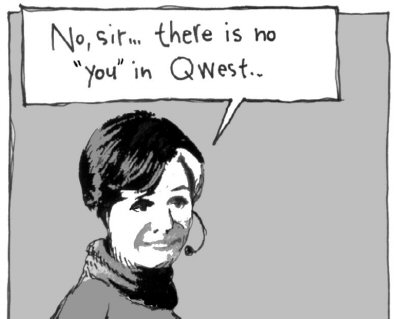
“It seems like the most logical option for Anschultz, given his huge investment in fibre optic, is to plan for the digital delivery of movies via QWest’s fibre optic network.”
Monaghan concluded, “Having been told by two [public relations reps] associated with both the Anschutz Company and Regal Entertainment that there is no basis in fact for the very colorful story you have somehow conjured, we do not expect to see any of this nonsense on your website or in any other medium.”
To which I replied, “I didn’t maintain that all of the reports and suppositions in my letter were factual, but I know that Anschutz’s investment in his vast fibre optic network is considerable. Elemental logic dictates that he would be loooking at deploying this network as part of a delivery-of-digital-movies strategy.
“I’m not saying I know that Anschutz is, in fact, doing this, but to characterize the basic elements of what I conveyed in yesterday’s e-mail as ‘conjured,’ ‘colorful’ and ‘nonsense’ with ‘no basis in fact’ defies credibility.
If this story came to you on the good authority of someone else,” Monaghan wrote, “and you feel compelled to believe them and not us, then I would expect anything you write to be fully disclaimed. That is, that you would identify the individual or individuals who have provided you this information … as well as our position that the story is completely untrue.
“I understand your position and thank you for conveying it,” I replied, “and I appreciate [the value of] your time and the courtesy that you’ve paid to me. At the same time, I hope you understand how difficult it is for me, and for anyone with a rudimentary understanding of the realities of 21st Century theatrical exhibition or distribution, to accept what you’re telling me as entirely candid.”

Monaghan had the last word when he wrote back this afternoon. “My answer was and is [that] there is no such plan,” he said. “If you find that answer misleading, so be it. To have answered in any affirmative manner would have been misleading.
“For you to twist that answer, however, to suggest that I’m claiming that Anschutz and/or Regal Entertainment ‘intends to stay with 35mm film projection’ is one of the most [amateurish] attempts at bogus journalism that I’ve seen in a long while.
“Of course the industry will change, and I assume that Regal will be competitive in whatever future environment presents itself. That’s not to say, however, that Anschutz or anyone else I know has a plan or is now developing a digital projection system.”
Of all the summer’s hot-sounding marquee titles, my biggest want-to-see is Richard Linklater’s The Bad News Bears (Paramount, 6.10). Everyone knows it’s Billy Bob Thornton as a surly, vaguely alcoholic manager of a kids’ baseball team, and understands this basically translates into another Bad Santa movie. I guess that’s the comfort factor — that heartwarming, exposing-minors-to-rot, slovenly-misfit-redeemed-by-innocence formula….as long as it’s done in a low-key way. Linklater mined this pretty well in School of Rock with Jack Black as the bum, so Bears will probably be smooth sailing. In any event, here’s the trailer . Gregg Kinnear and Marsha Gay Harden are the costars. I don’t know which of the kid actors has the Tatum O’Neal part, but I’ll bet one of them sorta does.

This is a few hours old, but it appears that Lars von Trier’s decision to have a donkey killed for a scene in his forthcoming Manderlay (which will have its debut screening in Cannes nine weeks from now) was all for naught. For the sake of realism, an ailing donkey was given an actual lethal injection for a scene in which hungry people kill a donkey for food. Reports about this provoked a big uproar from Scandinavian animal rights groups, and costar John C. Reilly quit the film in protest (and was replaced by Zeljko Ivanek), and Von Trier’s producer Peter Aalbaek-Jensen lived up his reputation as a subtle charmer when he told a Swedish reporter “that fucking donkey was going to die anyway.” But now von Trier has caved into the protests and is cutting the scene from the film, saying he doesn’t want the film’s political and social themes be overshadowed by a donkey. “The welfare of animals is important,” he told a reporter, “but the welfare of people is in my opinion even more so — part of this is free speech and political debate.” A Swedish newspaper reported that a mass e-mail campaign by more than 300 animal rights activists forced von Trier to cut it out. Von Trier said that the meat from the donkey was “passed along, so it could be a part of the food chain, which donkey meat is these days.” He admitted, though, that killing the donkey might have been a bit “pointless.” Here’s a link from a Swedish newspaper, and here’s another . Remember how Francis Coppola killed an ox (i.e., had its head cut off) in Apocalypse Now? I don’t remember anyone sqawking about that.
Blam Blam
It’s unusual for a 44 year-old guy from the fringe indie or straight-to-video world landing a directing gig with a mainstream studio like New Line.
Unusual because of age-ism (i.e., generational tribalism and the belief that new directors have to be in their late 20s or early 30s with two or three MTV music videos to their credit), and because of an unwritten stipulation that if a director hasn’t gotten on-board with a high-profile producer or distributor by age 40, he/she is probably “done” and been relegated to the sidelines.
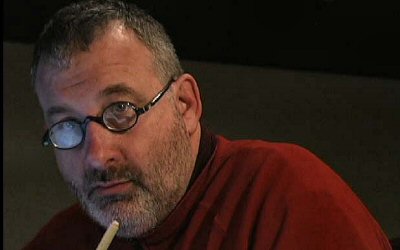
No, this isn’t Gus Spielberg, Steven’s younger, smarter brother who lives in Arizona — it’s Shoot “Em Up writer-director Michael Davis.
A noteworthy exception is Michael Davis, a Steven Spielberg lookalike whose success story is about one of the longest gestations in Hollywood history.
New Line has just committed to fund production of Davis’s script, a John Woo-type urban actioner called Shoot ‘Em Up, with Davis directing.
New Line president Bob Shaye has made it clear he wants the high-octane action flick rolling by September. He’s also signed Davis to a two-picture option agreement, and I’m told that Davis is now being wooed by agents for representation.
< ?php include ('/home/hollyw9/public_html/wired'); ?>
This is serious pay-dirt for a 1987 USC grad who’s directed a few lower-profile, straight-to-video films (the most admired is Eight Days a Week, winner of the audience award at the 1997 Slamdance Film Festival), and who has also worked as a storyboard artist off and on for roughly fifteen years, never quite putting his mitts on the brass ring.
I’ve read Shoot `Em up and it feels to me like a great New Line genre film in the tradition of The Hidden, the first Rush Hour, Blade and so on. It’s fast, punchy, sardonically funny, and aimed at younger guys and connoisseurs of action choreography-for-its-own-sake.
Journos are always being told that major stars are interested in playing a role in this or that script, but the talk is apparently valid this time. A serious “big name” is eye-balling Shoot `Em Up‘s lead male role, “Mr. Smith,” a terse hard-boiled type with the usual Joffrey Ballet abilities during gun fights.

A stick-figure image from Michael Davis’s 17-minute animatic Shoot ‘Em Up tape that conveys the choreography of the action scenes.
Why would a major star be looking at what sounds on the surface like a rote New Line actioner being made “for a price”? Because Shoot `Em Up ain’t rote.
The crusty, cynical noir-flavored tone is familiar, but the big action scenes have a kicky “haven’t been here before” quality. They take the Hong Kong Woo aesthetic to absurd new heights, but in a way that feels freshly insane, oddly logical and edgy-funny. It’s screwball formula nihilism with a twist.
Woo fans have seen a certain aspect of it before. The central Shoot `Em Up hook — a tough guy loner protecting a new-born baby boy from an army of goons trying to bring his just-begun life to a close — is borrowed from a sequence near the end of Woo’s Hard Boiled (’92).
Apart from the script itself, the element that sold Shoot ‘Em Up more than anything else was Davis’s decision to compose a 17-minute animatics reel, made from roughly 17,000 line drawings, which gives the viewer an idea of how the action scenes will play. (I could describe the action sequences and all, but this would spoil the fun down the road…right?)
I got a look at this tape last weekend and it definitely sells you on Davis as well as the piece itself. You figure any guy who cares this much about explaining how the action stuff will play has his gear wired tight and can be trusted to make it happen on film.
The people who pushed Shoot ‘Em Up into “go” project status are producer Don Murphy (along with his Angry Films team Rick Bennattar and Susan Montford, who will co-produce), New Line creative executive Jeff Katz and vp development Cale Boyter.
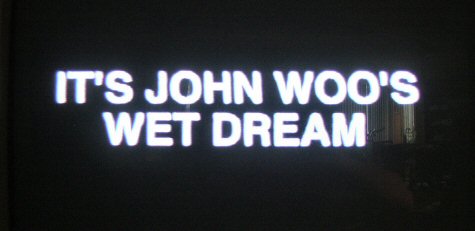
Copy insert from Davis’s animatic Shoot ‘Em Up tape.
Murphy had known Davis from USC film school in the late ’80s, and had kept in touch with him over the years. He knew he finally had something to push and maybe sell when Davis showed him the Shoot `Em Up script in the fall of ’03. It was hard and fast and could be made relatively cheaply…but Murphy wasn’t certain he could sell Davis as the director.
Murphy pushed it with New Line execs, although the first exec to make a call on it — senior vp production Stokely Chaffin — didn’t care for the “newborn baby dodging bullets” angle and said no. Murphy persisted and found an ally in Katz, who says he found the script “on the scrap heap…sometimes that’s how you find your little gems.”
Katz sent it along to Boyter, and the two of them eventually took it production chief Tobey Emmerich, who passed it along to Shaye.
Early on Murphy told Davis that “the biggest thing you can give me is some reason why [New Line] would let you direct it.” The animatics tape was the answer. “It said, look, he’s already visualized this thing, and look at how well these sequences play even with stick-figure drawings,” says Murphy. In so doing, Davis “really went the extra mile.”
Murphy knew Davis slightly “when I went to USC grad school in the late ’80s,” he says, “although he was two years ahead of me. He was one of those guys you meet and figure right away when they get out of school they’re going to be the schizzle. His shorts were great and he had an agent when he was still in school. But then we all got out and did what we did, and with Michael it was like…what happened?”
“I made some mistakes,” Davis says. “I was not politically savvy. I was an innocent and had no sense of politics and because I didn’t understand the political landscape in Hollywood, it hurt me. I always thought just sheer talent would be enough. I had an agent in film school. I could have gone with Richard Lovett or Jeremy Zimmer, but I went with a boutique agency instead.
“I also didn’t invest in networking and socializing. I just didn’t follow up on meetings. I guess I’m such a perfectionist….I didn’t want to just call up and be the fuller brush man, and I had too much self-doubt to just put myself out there and call these people.

“Stacy Sher at Jersey tried to help me get my first agent, and she’d take me out to lunch, wondering what I’d be doing. I didn’t keep up with her. I didn’t return the effort she put into me.”
The balancing factor was Davis’ way with a stand-out concept or oddball scene.
For Eight Days a Week he came up with the idea of a young horny protagonist having sex with food (i.e., shtupping a watermelon). If you ask me this bit was ripped off by the makers of American Pie. (How could the Weitz brothers claim otherwise?) Davis says he was “up” for directing that film until a certain Universal executive remembered the studio’s “mandate for hiring 25 year-old directors! I was too old…I was in my 30s!”
(John Hughes, one of Hollywood’s most successful miners of the teen aesthetic, was in his 30s when he made all those ’80s teen comedies. He turned 40 in 1990.)
Davis was a year or two ahead of Murphy at USC, graduating in ’87. He was a bit more contemporary with Jay Roach, Steven Sommers, Michael Lehman, John Turtletaub.
Davis has written 33 screenplays (ten of them produced) and directed five movies based on his scripts, the best of these being Eight Days a Week and 100 Girls, which went to video in the U.S. and “opened on 100 screens in France.” He’s done storyboard work for Pee-wee’s Playhouse and Tremors.
Murphy always “made me feel comfortable,” Davis recalls. “Over the years I’d send him my latest straight-to-video movie, and he always returned my phone calls. His attitude was always, ‘What can I do to help you?'”
It was a seven-month process, he says, before Shoot `Em Up got traction at New Line.
“Most producers shotgun things,” says Davis. “They send a script out, and if it doesn’t get heat they move on. Don is different.
“Jeff Katz liked Shoot ‘Em Up, but it stalled with Stokely. Don being Don, he wouldn’t let them pass on it. Katz loved the material..he was saying he’d never seen an action piece like this before. Then Cale Boyter saw it, got it and pushed it along. Then they all saw the reel.”
Davis “is not a young guy but this movie is happening and the agencies are going crazy for it,” says Katz.
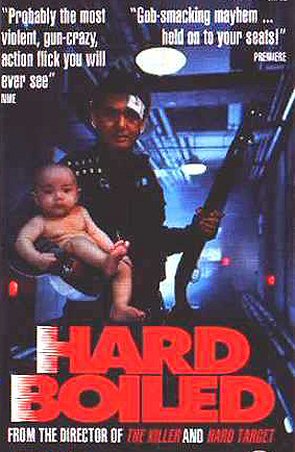
“[Murphy] told me I had to turn myself onto this. So we had a meeting with Davis and he looks like a pudgy Steven Spielberg. He’s this very happy-go-lucky guy, and what he did was map out a very inventive way to sell the gunplay. Shaye saw the tape and said yeah, this is good, get me the script.”
Writer-directors with talent, moxie and opportunistic backgrounds have about ten years to make their mark or establish a serious foothold of some kind after leaving film school. Most get there by their late 20s or early 30s. If they haven’t made it by 40 or thereabouts…toast.
Being a late bloomer myself (I didn’t really get down to journalism until I was 27), it’s nice to know that a slightly older guy has busted through, and for the right reasons.
Oscar Balloon ’05
Here’s the first assembly of ’05 Oscar Balloon picks. The same can be found down in the new mustard-colored Oscar Balloon box at the very bottom of the column.
Anyone with a line on any film or actor or behind-the-camera filmmaker of any stripe that they believe (and I mean on the basis of having read a script or actually having heard or been told something substantive, as opposed to hunches or assumptions) should be included, please forward the info and if it sounds credible, I’ll put it in.
BEST FEATURE: The Producers (Universal); All The King’s Men (Columbia); Untitled Spielberg Munich Olympics Project (Universal), Memoirs of a Geisha (Columbia); The New World (New Line); Jarhead (Universal), Elizabethtown (Paramount); Walk The Line (20th Century Fox); Cinderella Man (Universal); Syriana (Warner Brothers); Oliver Twist (Sony/Columbia).
BEST DIRECTOR: Steven Spielberg (Untitled Munich Olympics Project ); Ron Howard (Cinderella Man); Sam Mendes (Jarhead), James Mangold (Walk The Line), Terrence Malick (The New World); Rob Marshall (Memoirs of a Geisha); Roman Polanski (Oliver Twist).
BEST ACTOR: Matthew Broderick (The Producers); Viggo Mortensen (A History of Violence); Colin Farrell (Ask The Dust; The New World); Joaquin Phoenix (Walk The Line); Jake Gyllenhaal (Jarhead), Russell Crowe (Cinderella Man), Johnny Depp (The Libertine); Sean Penn (All The King’s Men); Eric Bana (Unititled Spielberg Munich Olympics Project).
BEST ACTRESS: Cameron Diaz (In Her Shoes); Gwyneth Paltrow (Proof), Zhang Ziyi (Memoirs of a Geisha); Reese Witherspoon (Walk The Line); Salma Hayek (Ask The Dust).
BEST SUPPORTING ACTOR: Nathan Lane (The Producers); Jamie Foxx (Jarhead), Peter Sarsgaard (Jarhead), Ben Kingsley (Oliver Twist); Paul Giamatti (Cinderella Man); James Gandolfini, Anthony Hopkins, Jude Law (All The King’s Men).
BEST SUPPORTING ACTRESS: Susan Sarandon (Elizabethtown); Hope Davis (Proof, The Weather Man); Toni Collette, Shirley MacLaine (In Her Shoes); Kate Winslet, Patricia Clarkson (All The King’s Men).
BEST ORIGINAL SCREENPLAY: Terrence Malick (The New World); Cameron Crowe (Elizabethtown).
BEST ADAPTED SCREENPLAY: Mel Brooks and Thomas Meehan(The Producers); Stephen Gaghan(Syriana), Steve Zaillian (All The King’s Men), William Broyles, Jr.(Jarhead), Susannah Grant (In Her Shoes).
Brando Blow-off
“You’re absolutely right about Brando getting short shrift at the Oscars. At least they kept the show reasonably brisk, but a full-up Brando tribute wouldn’t have consumed that much more time.” — Jay Smith
“I felt exactly the same way about Brando — he was robbed. It was insulting and stupid. Anything to do with Brando refusing to take his Oscar in ’73? An oversight? Who is responsible? They had a great opporunity to salute a legend and they lost it. Imagine the quotes they could have got from all the living Oscar-winning actors…De Niro, Pacino, etc. Shameful.” — Dale Launer, director-screenwriter.
“Maybe he wasn’t liked, maybe he didn’t play the game, maybe he took some air of the idea that someone could walk away…but tell me who did more for the performances and the quality of work that the whole night is supposed to be about? Oh right…Johnny Carson.” — Tom Van
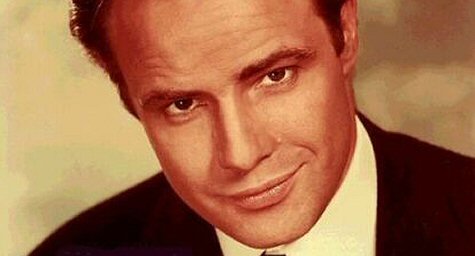
Marlon Brando
“You were right on target with your Brando comments. He’s probably the greatest thespian who has ever lived, and he delivered the best acting performance in cinematic history in Last Tango in Paris. I wonder if the oversight had anything to do with his personal troubles in his final years. If so, shame on the Academy.” — Ron Cossey
“Damned right they should have done a special thing for Brando, with Scorsese or somebody putting his complex and contradictory career into perspective. (Forget comedians– why doesn’t Scorsese just host the whole thing with commentary over the clips and footnotes at the bottom of the screen?)
“But Brando isn’t the only one who deserved that kind of separate attention– and I suspect this is the reason they didn’t do it. If they’d done one for him, it would have raised the question of why they didn’t do one for Ronald Reagan.
“By any decent logic, they should have acknowledged that a major place in history — not film history, but history– is held by someone who was once one of theirs. The problem, of course, is that a lot of people in Hollywood hated him as president, and if they were forced to recognize that maybe they were wrong then and that he did play a crucial role in ending a vast and terrible tyranny, they’d have to consider the possibility that they could be wrong about Bush and what’s happening in the middle east right now. And that, of course, won’t do.
“So instead of honoring either Brando or the man who said ‘Mr. Gorbachev, tear down this wall,’ the Academy chickened out by flashing them wordlessly on screen to bookend Fay Wray and Russ Meyer. But after all, how could we expect mere mortals like them to merit the level of loving tribute Hollywood reserved last night only for a true idealist and saint like the gulag-builder Che Guevara? Team America has never seemed more prescient.” — Mike Gebert.
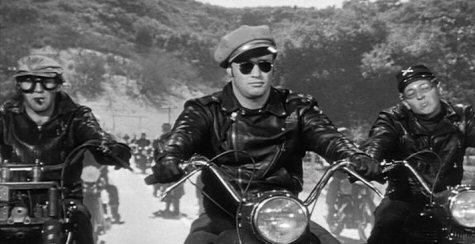
“It’s baffling to me that there was evidently no influential figure to push for a Brando tribute reel.” — Josh Martin.
“It seems clear to me that The Academy didn’t produce any special tribute to Brando because they didn’t feel they owed him anything. I can understand that. After all, he dissed them first. How could they give him special treatment after what he did while reducing other loyal members of the academy to a second each in a montage?
“Separate special memorials eat up too much time anyway. If they were that big a star (like Brando), they had enough press when they actually died. I had my fill of ’50s film clips of Marlon on MSNBC last summer. We didn’t need another review of his career last night. I can understand when they do it for Johnny Carson or Bob Hope because they had a special relationship with the actual Academy Awards TV program.” — P. Mccarthy.
Oscar Fallout
“I wasn’t looking forward to the Oscars this year, and almost didn’t watch for almost the first time I can remember. I’m not a fan of Chris Rock. But I did watch, and I enjoyed it, though it didn’t rank with the more memorable shows. Perhaps the straitjacket of the show actually made Rock funnier to me. You’re right about Johnny Carson, and, yeah, they should give Steve Martin whatever he wants next time.
“The Pepsi Spartacus commercial was such an affront to me that I will go out of my way to avoid Pepsi at all costs until the memory of that ad fades. Ugh. Sean Penn coming to Jude Law’s defense only seemed to play into the perception of him not having much of a sense of humor. Yeah, Clint should have been nominated for his M$B score. And yup, Collateral deserved more than a nod for Best Cinematography.
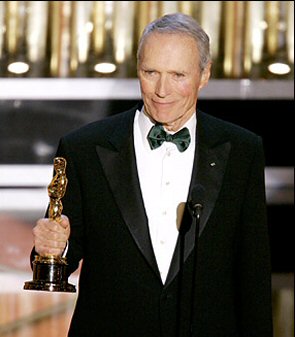
Clint Eastwood, director-producer of Million Dollar Baby and winner of the Best Director Oscar.
That The Aviator won is almost criminal, because the replication of early two-strip Technicolor processes left me scratching my head wondering if I was seeing a bad reel in the print when I saw the blue peas — and I’m a moviegoer who loved the Technicolor history documentary on the Robin Hood DVD! Who exactly got the homage to early color that they were doing? (I didn’t get it until I looked up the film’s trivia section at IMDB.) That conceit was the worst part of that movie. I had no problems with the CGI effects, and I’m usually pretty hard on that.” — Jay Smith
“The evening ultimately turned into a high mass for Clint Eastwood — the patron saint of on-time and under-budget filmmaking; the Hollywood trooper; the team player; the heartbreak kid; the poster boy for ageism in reverse; the proponent of simple storytelling for simple folk; the guardian against mass market/CGI-driven entertainment; the let’s-not-do-a-first-take,let’s-use-the-rehearsal-footage waste-management pro.
“I know you’re a fan of Million Dollar Baby but when it comes right down to it, the movie is nothing more than an old-fashioned melodrama torn from the pages of Warner Bros.’ own playbook from the 30s and 40s — only then they had actors with the grit and seeming street smarts to bring it all to vivid life: talents like Cagney, Bogart, Garfield, Pat O’Brien and the Dead End Kids. Now we have Clint playing Clint and Morgan Freeman tackling a role no different than all those serial killer movies at which he’s become so expert.” — Steve Chagollan
“Do you think that Collateral might have lost the cinematography Oscar because it was shot digitally? The images of LA at night were stunning, and to shoot so many scenes in the taxi…amazing work. That said, Robert Richardson√ɬØ√Ǭø√ǬΩs Aviator cinematography was worthy of the Oscar. The recreation of the Technicolor processes was amazing and the overall look of the film well worthy of the Award.” — Edward C. Klein, Salem, Oregon.
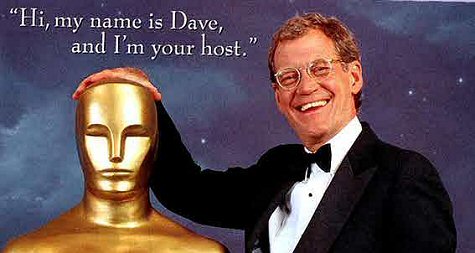
“I think the funniest moment at the Oscar in the last ten years was the Dave Letterman-hosted 1995 ceremony (a year that honored Forrest Gump and Pulp Fiction in different ways). There was that skit with several top names — Jack Lemmon, Martin Short, Paul Newman, Albert Brooks — acting to a sock monkey. The runner-up would be Billy Crystal’s intro to the 2000 ceremony, complete with Crystal spoofing Spartacus and showing up in drag as Mrs. Robinson.
— Michael Bergeron
“I can’t really stand it that so many people are crying over Eastwood not getting nominated for best score. Guarantee that if Lennie Niehaus wrote the same music note for note, no one would have cared (see Unforgiven). The real tragedy (well, not tragedy….life will go on) is that there were several great scores this year that came up empty in the awards department, while the five Oscar nominees ranged from okay to…okay.
Spartan, The Incredibles, I, Robot (the movie sucked but Beltrami knocked the music out of the park), The Motorcycle Diaries, Friday Night Lights and Kinsey are just a handful of great scores that went mostly unmentioned this year, yet everyone is crying over Eastwood’s ten notes. If he wasn’t going to win for Mystic River, he sure as hell wasn’t going to be recognized for Million Dollar Baby.
“It’s not even that the score was bad — it served its purpose. But there were far, far, far many better ones deserving of recognition, and now their composers have to sit around being told how Eastwood is superior to them too. If Danny Elfman or Carter Burwell haven’t won an Oscar yet, I think Eastwood can stand to miss out a few more times.” — Eddie Goldberger
Pepsi Spartacus
“So you liked Kirk Douglas and the gladiator army selling Pepsi — have you seen the ad with Gene Kelly’s Singing in the Rain remixed to sell VW Golfs? Here’s the link . The spot is pretty seamless, but I can’t help but cringe. I’ve been told that if I were to ever associate msyelf with something similar, I would be killed.


“Similar, but not selling anything, was the video mashup of the Beatles and Jay-Z. Someone took the initiative and blended A Hard Day’s Night footage with Jay-Z clips. Amusing if only to guess which Beatle would be the DJ and which was going to bust a move. [Editor’s Note: There was a link in this letter to the Jay Z video, but it didn’t work. If anyone has found one that works, please send it along.] — Chris Clark
Day and Date
“DVD’s or pay-per-view simultaneous with a theatrical opening sounds like a dream come true to me.
“Theatres won’t die out — they’d just be thinned out. Then maybe
a large percentage of the annoying crowd (families with 30 children in tow, talkers, etc.) would stay home. It’d be cheaper to rent a flick for $12 then it would be to pay admission for every child in your neighborhood. Ticket prices would go up, sure, but then maybe the quality of the experience would too.
“I’ll be honest — it’s getting harder and harder to pay upwards of $10 a person to see a movie maybe three days into the run and already there are a ton of scratches, pops and cigarette burns, not to mention faulty sound equipment. The experience is about as good sometimes for big budget fare in the theatre as it would be in my living room.” — Shawn Robare.
Asian Bootlegs
“Consider two developments regarding bootleg DVDs here in Asia:
“Movies open here on Thursdays…. the co-ordinated global released films actually get shown here one to two days sooner than the USA (by the time difference). The ticket prices vary from $2 to $8 for the equivalent service of a first class international flight (electric reclining seats and waitress service).
“I don’t subscribe to the bootleg industry, but apparently the bootlegs are now ‘off the master’ and nearly as good as the released DVD. Somebody is selling out at the major studios. I saw a snippet of a friend’s Million Dollar Baby copy and it was perfect.” — Paulus.

Crowds in Calcutta waiting for fresh shipments of pirated DVDs. Well, not really.
“You presented some interesting ideas about the future of film distribution. I for one would hate not to be able to see films on a big screen. I don√ɬØ√Ǭø√ǬΩt care how big a screen I have at home — I want the magical experience in a darkened theater.
“One scenario you didn√ɬØ√Ǭø√ǬΩt mention was digital projection. I haven√ɬØ√Ǭø√ǬΩt been able to see a film presented in this format, but from what I√ɬØ√Ǭø√ǬΩve heard it√ɬØ√Ǭø√ǬΩs stunning. If theaters start showing films this way and the films are worthy, just maybe people will start to fill the theaters again.
“Of course it doesn√ɬØ√Ǭø√ǬΩt help that they charge a small fortune to get in the door. My family and I wait until films come to the local Theater Pub where a ticket is $3 and you can enjoy dinner and a beer or glass of wine and see a decent film the way it was meant to be seen. And you don√ɬØ√Ǭø√ǬΩt have to put up with the poorly managed Regal Cinemas where all they want is your hard earned money and could care less if the film is focused or the sound is properly adjusted. And don√ɬØ√Ǭø√ǬΩt get me started on the conditions of the bathrooms!” — Edward C. Klein, Salem, Oregon.
Flipside
“I realize you liked Rock’s Oscar bit when he interviewed patrons at L.A.’s Magic Johnson complex. I’ve read a few other critics (including Tom Shales) who also seemed to like it. But you and Shales and the others may just be deluded honkies.
“Another interpretation of Rock’s interviews is that ‘urban’ audiences may just be completely out of touch with real cinematic quality. Unlettered, culturally limited boobs (as opposed, of course, to the hip, smarty-pants Rock). If a white guy had done those interviews, after all, the bit would have been correctly derided as racist, condescending and patronizing, as someone making fun of the less educated.

Chris Rock.
“But it’s better — okay, at least — if Rock (looking silly indded with earrings in both lobes) does it, right? Are you guys sure of that? And the presence of Albert Brooks is no guarantee either way that the skit was either racist or innocent. It just indicates how clueless Brooks himself may be about stuff like this.
“Good job on the Brando obit, by the way.
“Also, do you really imagine that, say, five years ago when you’re in a Mexican restaurant and there’s a mariachi-type version of this year’s winning song, you’ll truly remember it? I think not. Indeed, I don’t think any of us will remember any of the nominated songs one year from now.” — Richard Szathmary.

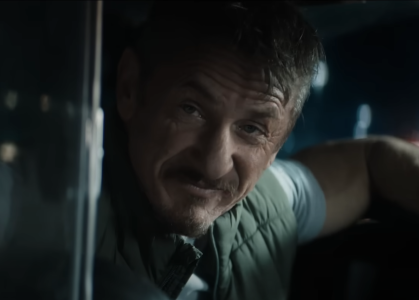 Really Nice Ride
Really Nice RideTo my great surprise and delight, Christy Hall‘s Daddio, which I was remiss in not seeing during last year’s Telluride...
More »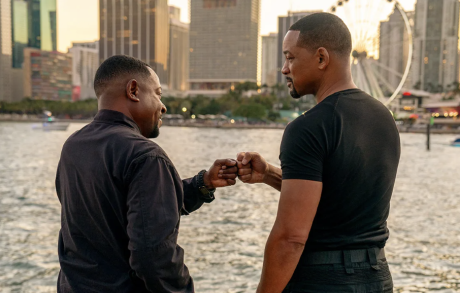 Live-Blogging “Bad Boys: Ride or Die”
Live-Blogging “Bad Boys: Ride or Die”7:45 pm: Okay, the initial light-hearted section (repartee, wedding, hospital, afterlife Joey Pants, healthy diet) was enjoyable, but Jesus, when...
More » One of the Better Apes Franchise Flicks
One of the Better Apes Franchise FlicksIt took me a full month to see Wes Ball and Josh Friedman‘s Kingdom of the Planet of the Apes...
More »
- The Pull of Exceptional History
The Kamala surge is, I believe, mainly about two things — (a) people feeling lit up or joyful about being...
More » 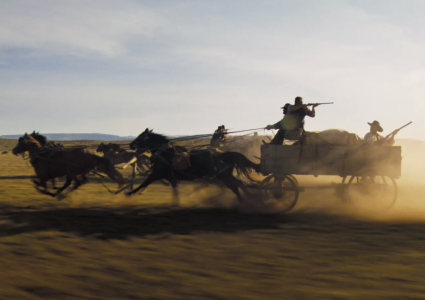 If I Was Costner, I’d Probably Throw In The Towel
If I Was Costner, I’d Probably Throw In The TowelUnless Part Two of Kevin Costner‘s Horizon (Warner Bros., 8.16) somehow improves upon the sluggish initial installment and delivers something...
More » Delicious, Demonic Otto Gross
Delicious, Demonic Otto GrossFor me, A Dangerous Method (2011) is David Cronenberg‘s tastiest and wickedest film — intense, sexually upfront and occasionally arousing...
More »


